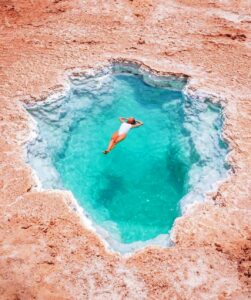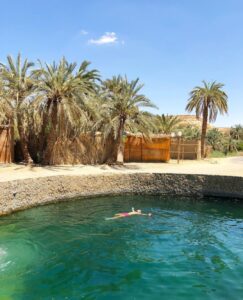- Siwa appears at first as a sweet and innocent place deep in the desert which has just opened its eyes to the modern world and still let’s itself be amazed. Which is not wrong, the asphalted road opened first in 1984. But the history goes deep beyond the earliest civilizations, to Paleolithic times. In the 1st millennium BCE, Siwa was famous with the ancient Egyptians, thanks to its oracle. The oracle was though to be so true and powerful that generals feared its predictions. Both when the Persian king Cambyses invaded in 525 and with Alexander the Great before his expeditions into Asia in 331 BCE, was the oracle consulted.
During these times, Siwa was a wealthy place, well illustrated by the Gebel al-Mawta and its rich tombs. In early Islamic times, Siwa went into decline and sometime in the 13th century was down as little as 200. Today the population is on the rise, and has since long passed 20,000. Most live in the town Siwa, the rest are spread across over 10 smaller villages.
Ruins of Shali
- The ruins of Shali dates back to the 13th century, and was in full use until 3 days of heavy rain destroyed it in 1926. The houses were originally built to last a couple of decades, then be rebuilt or fixed after light rain. The building material was kershef, a mixture of salt and clay. It is not water-proof. Shali is supposed to have risen 60 metres above the ground level of the oasis, helped by the two mountains here. It must have been a fabulous sight. It still is, but none of 5 story houses still stand.
- Shali today offers great view, the ruinous state have created many fine views. But surprisingly, you will find that some of the houses are still inhabited, although this only applies to the ones at the foot of Shali. The town of Siwa is the cutest thing, a couple of streets and a little park in front of Shali. If you head out one of the streets in eastern direction, you find yourself walking on sandy tracks going through well-kept oasis gardens. No wonder why so many people love this place!
- The oasis is easy to explore, there are numerous little tracks running through it. None are paved, sand is the thing here. Most of the time there are high palm frond walls facing the tracks, but anyone higher than 1.75 should have no problem looking in on the farms.
Gebel El-Mawta
- The Gebel al-Mawta looks great from a distance, but it is even more impressive up close. The name means simply Mountain of the Dead, and it is the place where Siwans for over 2000 years buried their loved ones. The mountain is truly perforated, it must be centuries since there was no more room for new graves. The lower part of the mountain has countless mounds, with small passageways to the tombs.
- Most of the tombs belonged to families, and arranged according to the same patterns as graves all around Egypt. The larger ones had ceremonial chambers, while the smaller ones had ceremonies performed outside the grave.
- The mountain holds a couple of truly great graves, full of wall-paintings equally beautiful to the noble tombs of Luxor or Aswan. Unfortunately, there are strict rules on photographing here, so the finest of the lot was out of reach of me and my camera.
Alexander's oracle
- The Oracle of Amon is today mainly remembered for being visited by Alexander the Great in 331 BCE, when he was seeking confirmation that he was the son of Zeus (whom the Greeks associated with the Egyptian Amon). Nobody knows what the oracle told Alexander, the answer was whispered into his ear. But it probably was confirmative; Alexander expressed ever since a wish to be buried at Siwa, and he embarked upon great conquests in the east, conquests that only a son of a god would dare to embark upon.
- The oracle of Siwa was one of the 6 most influential in the known world of those days. It probably came into use some time in the 6th century, as an expansion of the up to 200 year older temple dedicated to Amon-Re. The impact of this site in ancient times appears slightly strange and fascinating at the same the same time to modern visitors. The actual temple is so small, but the entire setting is like out of a fantasy novel. The temple complex, complete with a well (quite well-preserved) takes all of a little mountian rising up from the oasis. Seen from a distance, the site is like a white island floating on green palms. Upon entering, a wall rises above you, and when standing next to the temple you will have fabulous views.
- Unfortunately, there is little to fascinate a visitor with the temple structure itself, no wall-paintings and no fine details have survived. It is best when seen from a distance. The temple itself. It is really very small, but as most visitors never were allowed to enter, just stand on the ground 12 metres beneath, it probably appeared to be quite impressive.
Temple of Amon
- If the oracle has been badly treated by time, the Temple of Amon is in an even worse condition. Just a piece of a wall still stands, held up by crude modern bricks. Fortunately some fine wall-paintings on the western side of the wall have survived.
- It is believe to have been built by the command of King Nectanebo 2 in the 4th century BCE. It would have been standing if it hadn’t been for an Ottoman general who blew it up in 1896 to get building material.
Cleopatra's Pool
- It sounds like an historical place, but there is no reason to believe that Cleopatra had anything to do with it. The fine name indicates however that this is one of Siwa’s nicest pools. Nowadays it is used by local men for bathing, but foreign female visitors will not be denied entry. It was formerly used by local brides for bathing, but that practice has now moved to the nearby Tamusi bath, which is more secluded.
- Cleopatra’s Pool has a little cafe, sheltered from the sun and good for hot days.
Gebel Dakrur
- There is no better place to take in fabulous views over the entire oasis than at Gebel Dakrur. It is a fair climb, but can probably be vertigous for some.
- The mountain has three peeks, and lies near the Birket Zeitun. But there are stunning views over the western part of the oasis too.Every year, the Tourist Festival is held on the mountain’s foot.
Fatnis Island
- Fatnis Island
- The Fatnis Island lies about 10 metres out into the Birket Siwa, and is completely covered by palms, except for the circular, tiled pool. The entire setting is beautiful, actually quite romantic should that be of any use for you. Coming out here, best done by a bike (just ask any you pass by for “Fatnis”), an hour or so before sunset is perfect. You start with swim, then head down to the coffee shop to take in the sunset over the Libyan Desert.
- The total experience here was even better before, and as the water has been sinking due to some much needed drainage projects, Fatnis might not stay an island in the future.
Alexander's Tomb
- Siwa hit the news in 1991 when it was claimed that the tomb of Alexander the Great had been found. It was a structure with Macedonian inscriptions in Greek letters, it was 55 metes long and complete with much decorations.
- It had been discovered by Greek Liana Souvlatzi, but the dimensions of the possible discovery apparently clogged her objectiveness. It was later on discovered that some of the inscriptions had been misread, and now she is not allowed to return to the site for further excavations.
- The most popular theory for the tomb is that it belonged to a Macedonian general. However, the tomb might give hints to where Alexander is buried. It is not certain that he was even buried in Siwa according to his wish, rathar in Alexandria.
- For the casual visitor, there is little to see except the long corridor. All moveable objects have been put into sealed storage rooms.
Birket Siwa
- The Birket Siwa is the visually most attractive of the two salt lakes of Siwa. It starts where the palm groves end, and it is framed by table-top mountains. The largest is the Adrar al-Milal, or White Mountain.
- Today the lake is receding and it is becoming more and more saline. Much of it has now a surface of thick crust.
- Birket Siwa is best visited as a part of a trip to Fatnis Island. There are passageways running from the island and out into the lake. This does not give the impression that you cross the lake, there are less and less clear borders between lake and land.
Birket Zeitun
- Far fewer visit the lake of Birket Zeitun than Birket Siwa.The reason is simple, it is not as visually impressive. The surrounding landscape is fairly flat. There are several villages along the northern shore of the lake, all made from prefab material, making it all look quite tragic compared to the sweet irregularity of the town of Siwa. But there some really fine palm groves here, several pools, and friendly people not as spoiled with seeing foreigners as the central Siwans.
Well of Abu Shuruf
- Abu Shuruf is famous in Siwa for its fine pool as well as its many female donkeys. The pool is one of the most inviting in all of Siwa, few by the fiercest well of them all. Warm water gushes out of the ground not too far away from the oval pool. The female donkeys is another matter, and of course you will not notice this unless you know a bit about donkeys. It is supposed that the Siwan saying “Have you been to Abu Shuruf” is a question to a man if he has had sex.
Bir Wahed
- Bir Wahed is both one of the new tourist traps of Siwa, and a quiet, secluded place for spending the late afternoon and evening. This is a well set out 12 km southwest of Siwa. It is truly a veird place, with water right in the middle of the sand dunes, without the typical oasis vegetation.
- Bir Wahed is visited as part of a 4WD excursion, and is considered to be the best place for women to bathe, as there are no locals here.










